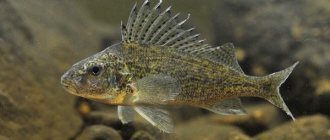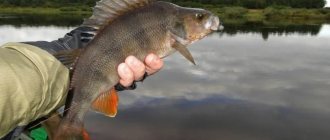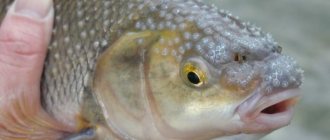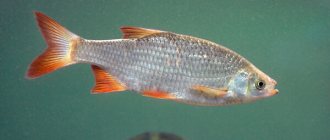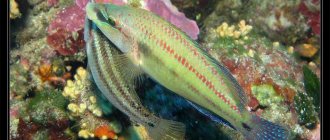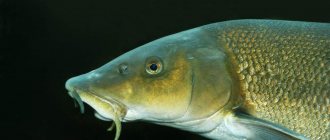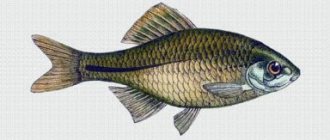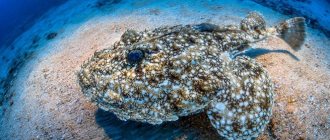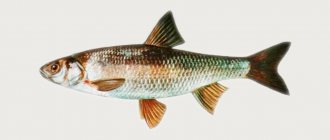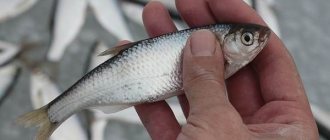Among the huge variety of the most diverse aquatic inhabitants, there is one interesting small fish that lives in rivers, ponds, ditches and swamps. This unpretentious fish is called a minnow, the varieties of which differ in both size and color. It can easily be found in muddy waters, polluted ponds, and swampy lakes.
Among them there are common minnows, Chinese minnows, etc. There are two forms: lake and river.
This article below provides more detailed information about this fish: description, features, distribution and habitat, etc.
Golyan: description, photo
The small fish belongs to the carp family. In total, there are approximately 15 varieties of this fish.
The main feature of the minnow is its color - bright, especially during the spawning period. The beautiful skin of the fish, iridescent with rainbow colors, is covered with delicate small scales, and larger scales are found only on the midline of the back and belly.
Minnow is a fish that, like bitterweed and verkhovka, is one of the smallest. Its dimensions are only about 10-15 centimeters in length, and its weight is approximately 100 g. Female minnows are large compared to males. The latter have a blunter nose shape and a brighter color. In males, the nose and head are covered with sharp warts.
The minnow differs from other representatives of cyprinids in its wider body, the number of pharyngeal teeth and small scales. Therefore, this fish has its own genus - Phoxinus.
A distinctive feature of the minnow is its extraordinary diversity, and therefore the names belladonna and buffoon are more suitable for it. Her back is greenish with burgundy tints, less often bluish, with a dark stripe along the middle of the back. The sides are yellowish-green with a golden sheen, turning closer to the belly into silver. The belly from the very lips to the caudal fin is reddish and sometimes white (minnows of the Sviyaga River). The yellowish fins are edged with black, and their eyes are silver with yellowish tint.
It is difficult to accurately describe this fish by color, especially since its color can change depending on the time of year and the habitat. The most beautiful bright minnows can be observed during their spawning period.
In eastern Russia there is another type of such fish - relatively large minnows covered with large scales. They differ in their lifestyle and appearance (body shape and blunter muzzle).
In general, the color of minnows can vary quite a lot depending on their habitat and air temperature. All subspecies of this fish are different in color; for example, the common minnow has a lateral line that reaches only to the middle of the body, which then gradually disappears.
Lake minnows
A quiet, overgrown lake near the town of Sudogda in the Vladimir region is a place where vacationers go on picnics, and a few fishermen wait for a bite of fat crucian carp. Usually the fish composition of such reservoirs is quite simple - silver, less often gold, crucian carp, occasionally tench and verkhovna, often the ubiquitous invader from the Amur - sleeper. However, in the last few years, local fishermen began to catch an unfamiliar species of small fish in the lake, whose color and build slightly resembled young molts. This is a lake minnow. In recent years, it is increasingly found in reservoirs in regions neighboring Moscow.
Text: Andrey Yakovlev
It is believed that the lake minnow has an extensive but interrupted range - in Western Europe the minnow inhabits lakes in the basins of the Oder and Vistula rivers, in the European part of Russia it lives in the basins of the Dnieper, the Middle Volga (Oka and Kama) - in particular, in the territory of the Vladimir, Nizhny Novgorod regions and the Republic of Tatarstan. But this species is especially numerous in the river basins flowing into the Arctic and Pacific oceans in Russia, Kazakhstan, Mongolia, China and Japan.
However, not everything is so simple with this fish. The fact is that even the classic of Russian ichthyology, Lev Semenovich Berg, noted that the lake minnow is a rather variable species. According to the practice of those years, it was accepted to distinguish subspecies, in particular, Manchurian, Sakhalin, Middle Volga, Danzig, Poznan, and Polish were distinguished. And indeed, if you look at the lake minnows of the Vistula, Kama and Siberian rivers, it turns out that these fish differ quite greatly from each other both in body proportions and in the number of perforated scales in the lateral line (in other words, some minnows have a complete lateral line, others others end in the area of the anal fin). These are quite significant differences.
But it must be said that at present the taxonomy of lake minnows has not yet been completely established. Many experts consider the differences between minnows from different parts of their range to be not very significant and believe that all populations of the lake minnow belong to the same species; but at the same time, more and more works are appearing in which some of the subspecies identified by Berg are considered as independent species.
In our country, the scientific name of the lake minnow is currently used - Rhynchocypris percnurus (Pallas, 1814), European scientists use a different generic name - Eupallasella. And although a unanimity of opinion has not yet been achieved here, it is still recognized that this type of fish is so different from its fellow minnow Phoxinus phoxinus that combining them into one genus is not very correct, yet these fish are completely different from each other .
Unlike the common minnow (or belladonna), which prefers clean, cold water with a fast current, the lake minnow inhabits almost exclusively silted, stagnant, overgrown reservoirs, and also has significant differences in body structure and biology.
However, there is little confusion with the name of the genus; a curious historical incident is connected with the history of the description of the lake minnow - taxonomists for a long time could not decide how to write correctly - Rhynchocypris percnurus or perenurus. Usually everyone uses the epithet given by the person who first described the new species. In this case, it is Peter Simon Pallas, who described the lake minnow in his seminal work “Zoographia Rosso-Asiatica...” (1814). But in different copies of the 3rd volume of the reference book, this name is printed differently due to the replacement of the letter during the printing process (replacement sequence: “from” to “e”), and in the title of the description a letter is completely missing, so at different times the writing The species epithet of the lake minnow varied. It would seem that it is just one letter, but the scientific name is a kind of “passport” of the fish in the system of living nature, and it should not allow for discrepancies. Pallas himself never explained the etymology of the name he assigned, however, despite the obvious typographical error, the variant “percnurus” seems correct also because it carries a semantic load and can be interpreted (“percnos” - eagle; “oura” - tailed), whereas perenurus does not. True, it is not very clear which “eagle tail” Pallas had in mind.
Currently, the trend in the taxonomy of these fish is that lake minnows will be divided into 4 species:
- The common lake minnow Rhynchocypris percnurus (Pallas, 1814), inhabiting the basins of the Oder and Vistula rivers in Western Europe, also inhabiting the territory of Belarus and Ukraine, and in Russia it has a gigantic range, covering Siberia and the Far East.
- Middle Volga lake minnow Rhynchocypris stagnalis (Berg, 1907). It is this minnow that has become increasingly observed in the reservoirs of the Vladimir region; its range is limited to the reservoirs of the Middle Volga basin.
- Sakhalin lake minnow Rhynchocypris sachalinensis (Berg, 1907). Endemic to the islands of Sakhalin and Hokkaido. On Sakhalin, it is distributed in the basin of reservoirs of southern Sakhalin, the large rivers Tym and Poronai and the lagoons of northeastern Sakhalin.
- Manchurian lake minnow Rhynchocypris mantschuricus (Berg, 1907). One of the most widespread fish species in the inland waters of Sakhalin, it is widely distributed in the south and southeast of the island, in the basins of the Tym and Poronai rivers and in the north in the reservoirs of the Okha region (but not recorded on the Schmidt Peninsula). In the northeast of the island it is found in the basin of the Piltun, Chaivo, Dagi and Nyisky lagoons, in lakes and peat quarries adjacent to Lunsky and Nabilsky bays. In addition to Sakhalin, it lives in the southern part of the Amur basin, the rivers of Primorye and the Korean Peninsula. In the Lake Khanka basin it is numerous in collectors, quarries, non-drying coastal puddles and in the oxbow lakes of Komissarovka, Melgunovka and Spasovka.
Although all minnows are fairly small fish, this species is relatively large, reaching a length of up to 18 cm (although usually still less, 8–15 cm) and a weight of up to 100 grams.
The general body tone of the lake minnow is golden, the back is greenish-gray or dark brown, the sides have a greenish tint and small dark spots scattered throughout the body. The dorsal and caudal fins are greenish-gray, the pectoral, abdominal and anal fins are yellowish, with a reddish tint. Like many other fish species, the intensity of color depends on the transparency and color of the water.
The body of the fish is thick and high, the mouth is small, terminal, slightly raised upward. The pharyngeal teeth are double-rowed, slightly compressed laterally, and on the upper part form a ridge with a hook at the top. There are 8–9 gill rakers on the first gill arch. The fins are relatively short, rounded at the apex, and the caudal fin is slightly notched. The dorsal fin begins slightly behind the base of the ventral fins and contains 3 unbranched and 6–8 branched rays. The anal fin has 3 unbranched and 7 branched rays. The scales are larger than those of an ordinary minnow, dense, and smaller on the belly and throat.
The lake minnow is a schooling fish that spends most of its life in the bottom layers, only occasionally rising to the surface in search of food.
In summer, it stays in the coastal strip among dense aquatic vegetation. During the day, schools of minnows constantly move from one place to another, and in bad weather they descend to deeper parts of the reservoir. This fish spends the winter hibernating, buried in the mud. It easily tolerates oxygen deficiency and warming of the reservoir to temperatures above 30 °C.
It becomes sexually mature in the second year of life with a length of 6 cm. It begins to spawn in May - June when the water warms up to 9-11 ° C, spawning continues throughout the summer. Spawning is portion-based; the lake minnow lays sticky eggs with a diameter of about 1 mm on aquatic vegetation. Fertility - 19–26 thousand eggs.
It feeds on algae, detritus, insect larvae, mollusks, other benthic organisms, and less often on the insects themselves, and can consume fish eggs. In its habitat, even in the smallest bodies of water it reaches very high numbers. Catching it is not difficult: the fish is not particularly cautious, and it is easy to catch it with the simplest “spider” lift.
In the east of its range, the lake minnow (where it is called “mundushka”) reaches its maximum size, and in some places, especially in Yakutia, it was even a commercial species. At the same time, in the western part it is much smaller.
In a number of regions of Russia it is rare - for example, the Middle Volga lake minnow is included in the regional Red Data Books in the Vladimir, Nizhny Novgorod regions and the Republic of Mordovia. The species is also included in the Red Data Books of Ukraine and the Republic of Belarus.
Fish names
Other names for minnows are minnow, minnow, shank, shank, variegated, motley, variegated. They reflect the external feature of the minnow - the belly of the fish has no scales and it has a variegated color. And in fact, many minnows have spots of various sizes scattered on a greenish background with a golden tint on the side of the body.
Another name is very suitable for this fish - demoiselle minnow, because some of them have bright, beautiful fins.
There are minnows with such incomprehensible names: soldier, Circassian, Cossack. The shape of these fish is spindle-shaped, the head is relatively large. Their length is no more than 12 centimeters.
Description
The body of the minnow is spindle-shaped, not laterally compressed. The lateral line is incomplete or discontinuous. There are no scales on the belly. Usually the scales do not overlap each other, especially in the front of the body. The pharyngeal teeth are double-rowed. Vertebrae 37-41. The mouth is small, terminal, semi-inferior. The upper jaw is slightly curved. The eyes sit high; forehead flat, narrow. Gill rakers from 8 to 11 (sometimes 5-6). The belly is bare, only behind the gill opening on each side there is a strip of 7-8 rows of scales on the belly. The pectoral and ventral fins are rounded. The dorsal and anal fins are truncated or slightly rounded. The caudal fin is noticeably notched; its blades are pointed at the ends. The tail stalk is long and thick. The scales on the body are very small. The lateral line has an average of 80-92 scales.
Spreading
Minnow is a fish widely distributed throughout the European part of Russia; it is also found in Siberia (Yakutia) to the Yenisei River basin. In Russia, this fish is often found in its fresh water bodies, but in the south there is slightly less of it than in northern water bodies.
There is a lot of fish in the mountain rivers of the Caucasus, in the Trans-Urals, in the Crimea, and in the lakes of Altai. They are also found in small lakes near villages, but due to the small size of the minnow and the muddy water, it is difficult to see them.
In addition to the river minnow, there is also a lake minnow that lives among the vegetation in the coastal zone, where it finds its food. Moreover, it can even live in the brown water of a swamp, where there is practically no oxygen. The lake minnow is found in lakes that flow into the Arctic Ocean and in numerous lakes associated with the Kama, Volga, Dnieper, Vyatka, Amur and Oka.
Habitat
The minnow fish lives in the rivers of North America, Asia and Europe. It is quite common in the rivers of the Northern Urals, especially on the eastern and western slopes of the ridge. Some species prefer marsh channels, ditches and well-aerated reservoirs. The lake minnow is well known in Yakutia. Local residents call this small fish (no more than fifteen centimeters long and weighing about one hundred grams) “mundushka” from the word “mundu”. Translated from Yakut, this name means “lake minnow fish.”
Minnow Habitat
Common minnows are freshwater fish. Moreover, they prefer cool water, so they mainly live in rivers with a rocky bottom and strong currents. These fish do not like warm water and calm currents, which is why they are rarely found in large lakes and rivers, where the water is calmer.
More accurate information about their distribution has not yet been fully revealed, since minnows are very small. However, given that they are found in large quantities in many rivers, we can conclude that this fish lives almost everywhere.
Basically, common minnows live in streams, as well as in small rivers, and they reach almost to the source, where other species of fish are not observed. In mountainous areas, minnows can rise in rivers to significant heights - up to several hundred meters. For example, they can often be seen in reservoirs of the Ural Mountains.
Most of the time these fish live in schools on rocky rifts. Moreover, these schools can contain up to several thousand minnows, which are located in rows one above the other. The largest individuals, as a rule, stay closer to the bottom, and the small ones – higher.
The largest schools of fish are found near the coast because the current is weaker there. They feed on mill beads that fall into the water, and their traditional diet is small worms, crustaceans, midges, mosquitoes, etc. They can also feed on fish fry, various carrion, and, a little less often, algae.
About the spawning period
Alone minnows are very rare. Their flocks are especially numerous during the breeding season. In Russia, this season falls on May-June for river fish. Lake minnows spawn later - early or mid-July.
Spawning among minnows is peculiar, according to observers. Males gathered in flocks pursue less numerous females. One of the females is surrounded by several males and stays close to her. The strongest two males squeeze her on the sides, after which eggs emerge from the female’s body and are immediately fertilized. These males are then replaced by others, and this continues until the female is left without eggs. During the spawning period, the males' fins are painted in surprisingly bright colors. The main enemies of the fry are mosquito larvae. From them, the fish find shelter in gravel or sand. Sexual maturity in these fish occurs approximately in the second or third year.
Spawning
Puberty begins at two years of age. With the onset of warm weather, schools of fish return to their traditional habitats where spawning takes place. In the spawning flock, there are approximately two times fewer females than males. At the beginning of summer (from mid-May to the end of July), they begin spawning. The bravest males approach the female (and those females who are not yet ready run away) and begin to squeeze her from the sides. Spawning occurs and the eggs are immediately fertilized by other males. During the season, the female spawns up to a thousand eggs, laying them on rocky and pebble soils. The fertilized eggs adhere to the underside of the stones. The hatched larvae hide from the eggs between the stones until they begin feeding on their own. Closer to winter, in late autumn, they will bury themselves in the silt and spend the winter there. Life expectancy is approximately five years.
Companions of the minnow
Usually in the fall the minnow completely disappears, and in the winter it buries itself in the mud or takes refuge under the roots of underwater plants and trees. But the practice of fishermen has shown that they are found in the water even in winter. It should be noted for fishermen that in winter the minnow avoids very shallow places, as well as the deepest ones.
These small fish prefer shallow rivers with cold, clear water, with a pebble, rocky or sandy bottom. They can often be seen in streams. Usually trout are found in such places along with them. The minnow is also a frequent companion of juvenile salmon fish. As noted above, these fish always gather in large schools. Wherever this fish is found, there are always a lot of them, which explains their omnivorous nature. And they feed on everything edible that is in the water.
Minnows, like goldfish, can thrive in any aquarium.
Minnow fishing
Due to its small size, this fish is not specifically caught even by amateurs. But while fishing, it often gets hooked by fishermen. Although the taste of the minnow is low, especially the river minnow (the fish meat is bitter), no one thinks of throwing away this tiny fish. And all because it is perfect for bait. Small fish are used as live bait when fishing for perch, pike, chub, trout, pike perch, grayling, and burbot. And it’s easy to catch a minnow, since it greedily and deeply swallows a hook with bait, so you need to hook the fish right away. It bites on maggots, small insects, worms, flies, pieces of bread, dough balls, as well as on the roots and shoots of algae. Larger specimens of minnows live closer to the bottom, and the smallest fish mostly swim on the surface. You can catch a dozen live baits for fishing on large river or lake predators in a fairly short period of time. However, it should be remembered that the minnow “falls asleep” extremely quickly in the bucket, even though the angler will change the water quite often.
Amur minnow
This variety of minnow is larger in size than others. Its dimensions reach a length of up to 24 centimeters. This fish is one of the most abundant freshwater fish that lives in cold, fast-flowing semi-mountain rivers. The Amur minnow lives in places with a rocky bottom and a slightly slower flow, as well as in places where the bottom is silted and covered with vegetation.
This fish serves as food for many predatory fish. These are taimen, lenok, grayling and pike.
This species is quite widespread in the Amur River basin. Also, the Amur minnow in Primorye lives in the basin of the Razdolnaya River and in the rivers of the Sikhote-Alin slope (eastern side).
Fishing methods
In the warm season, minnow can be caught throughout the daylight hours, with the exception of cold and windy periods, as well as thunderstorms. This fish does not bite at night.
Catching minnows is easy. Small fishing rod, light float, pellet weight, hook No. 2.5–3.5, bait – worm, maggot, bloodworm, burdock moth larva.
Sometimes a minnow in deserted and rarely visited places does not bite at all on plant baits - on dough and bread crumbs - which it does not refuse in other conditions.
The minnow is trusting and actively bites, even when it sees a fisherman standing on the shore. In a small transparent barrel you can clearly see how colorful, beautiful fish rush towards the worm, how the most agile one grabs it by the tip and rushes away from competitors, swallowing its prey as it goes.
Minnows are caught mainly for bait, although minnows fried in oil are quite tasty.
Fishing
The minnow is not a serious fishing target. Due to the fact that these fish are very small, fishing enthusiasts pay little attention to them. For the most part, this fish is used as bait for catching predatory fish. Trout, pike, burbot, perch and chub bite on them.
Despite all of the above, there are anglers who go fishing specifically for minnows. They prefer to catch such small fish in order to feel the pleasure of the fishing process. This applies precisely to the case when fishing is part of an active recreation, and not an integral part of profit.
To catch minnows, it is better to use a float rod. The minnow does not bite at night, but it is excellent to catch in the morning and during the day. What do minnows bite on? It bites well on worms, maggots and house flies.
Often this fish is caught with nets or head over heels.
When is the best time to catch minnows?
Minnows can be caught all year round, but in the depths of winter, when severe cold sets in, the minnow stops biting, burrowing into the mud. On the first and last ice it can still be caught using jigs, as well as other baits, both artificial and natural.
Fishing gear used:
- thin fishing lines;
- sinker-pellets;
- floats;
- light fishing rods (with good sensitivity), 4-5 meters long.
Bait
It swallows the bait quickly and insatiably. Fishermen use it as:
- pieces of dough or bread crumb (rolled into small balls);
- flies;
- small grasshoppers;
- maggots;
- moths;
- small red worms.
In reservoirs where trout are found, this fish is a favorite delicacy and is the prototype of very effective wobblers and minnow imitation for catching trout and other predatory fish.
Particularly tasty minnow is fried in a frying pan, as well as smoked in a home smokehouse. Residents of Germany whose cities are located in close proximity to the river. Reina (where it is found in incommensurable quantities) is considered the most delicious fish. But be that as it may, in most cases, the minnow is most often used as bait
